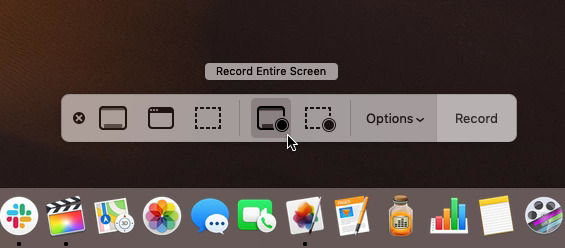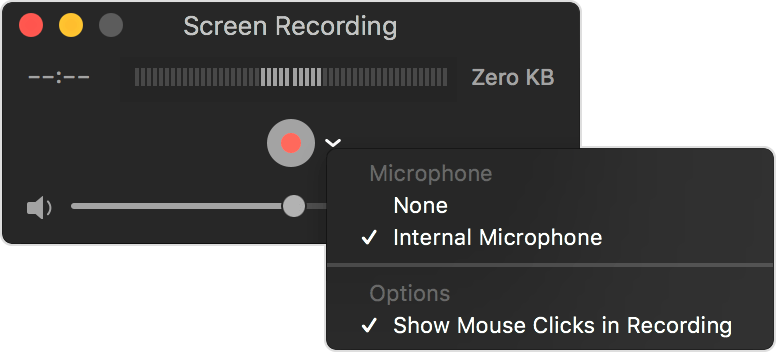Use the Screenshot toolbar
- How To Screen Record On Mac With Voice
- How To Screen Record On Macbook With Voice
- Screen Record On Macbook
- Record Video On Mac
- Screen Record On Mac Free
To view the Screenshot toolbar, press these three keys together: Shift, Command and 5. You will see onscreen controls for recording the entire screen, recording a selected portion of the screen or capturing a still image of your screen:
At this point, you will hear no sound from any of your Mac’s applications, but don’t worry. Go to the QuickTime Player application; choose File/New Screen Recording. Choose if you want to record all your screen, or a portion of your screen (highlighted in red below), then click on the Record button. Click on the Options menu. Click 'Record System Audio' to capture the sound playing on your Mac Click 'Record Microphone' to record your voice Click 'Record Camera' to record your FaceTime camera Select the area of the screen (or full screen) to record. Many Mac users find themselves wondering how to record the screen on a Mac with sound. This is such a common question because the built-in tools that Apple provides for recording video from the screen do not properly record the audio, a fact that isn't immediately obvious when you start the recording process.
Thankfully, screen recording today comes built into every major computing platform in some fashion or another. In this guide, we’ll explain how to screen record on Windows, macOS, iOS and Android. Free screen recorder to record your screen, computer sound & your voice. Share your captures fast. Instantly & securely. Available for Windows, Mac & Linux. Wistats 1.0.1.
Record the entire screen
- Click in the onscreen controls. Your pointer will change to a camera .
- Click any screen to start recording that screen or click Record in the onscreen controls.
- To stop recording, click in the menu bar. Or press Command-Control-Esc (Escape).
- Use the thumbnail to trim, share, save or take other actions.
Record a selected portion of the screen
- Click in the onscreen controls.
- Drag to select an area of the screen to record. To move the entire selection, drag from within the selection.
- To start recording, click Record in the onscreen controls.
- To stop recording, click in the menu bar. Or press Command-Control-Esc (Escape).
- Use the thumbnail to trim, share, save or take other actions.
Trim, share and save
After you stop recording, a thumbnail of the video appears briefly in the lower-right corner of your screen.
- Take no action or swipe the thumbnail to the right and the recording will be saved automatically.
- Click the thumbnail to open the recording. You can then click to trim the recording or click to share it.
- Drag the thumbnail to move the recording to another location, such as to a document, an email, a Finder window or the Bin.
- Control-click the thumbnail for more options. For example, you can change where your recordings are saved to, open the recording in an app or delete the recording without saving it.
Change the settings
How To Screen Record On Mac With Voice
Click Options in the onscreen controls to change these settings:

How To Screen Record On Macbook With Voice
- Save to: Choose where your recordings are automatically saved to, such as Desktop, Documents or Clipboard.
- Timer: Choose when to start recording – immediately, 5 seconds or 10 seconds after you've click to record.
- Microphone: To record your voice or other audio along with your recording, choose a microphone.
- Show Floating Thumbnail: Choose whether to show the thumbnail.
- Remember Last Selection: Choose whether to default to the selections you made the last time you used this tool.
- Show Mouse Clicks: Choose whether to show a black circle around your pointer when you click in the recording.
Use QuickTime Player
- Open QuickTime Player from your Applications folder, then choose File > New Screen Recording from the menu bar. You will then see either the onscreen controls described above or the Screen Recording window described below.
- Before starting your recording, you can click the arrow next to to change the recording settings:
- To record your voice or other audio with the screen recording, choose a microphone. To monitor that audio during recording, adjust the volume slider. If you get audio feedback, lower the volume or use headphones with a microphone.
- To see a black circle around your pointer when you click, choose Show Mouse Clicks in Recording.
- To record your voice or other audio with the screen recording, choose a microphone. To monitor that audio during recording, adjust the volume slider. If you get audio feedback, lower the volume or use headphones with a microphone.
- To start recording, click and then take one of these actions:
- Click anywhere on the screen to start recording the entire screen.
- Or drag to select an area to record, then click Start Recording within that area.
- To stop recording, click in the menu bar or press Command-Control-Esc (Escape).
- After you've stopped recording, QuickTime Player opens the recording automatically. You can now play, edit or share the recording.
Learn more
- The Screenshot toolbar is available in macOS Mojave or later.
- When your recording is saved automatically, your Mac uses the name 'Screen Recording date at time.mov”.
- To cancel making a recording, press the Esc key before clicking to record.
- You can open screen recordings with QuickTime Player, iMovie and other apps that can edit or view videos.
- Some apps may not let you record their windows.
- Find out how to record the screen on your iPhone, iPad or iPod touch.
To record your Mac’s Screen with both audio and video:
- Install loopback audio (free extension).
- Open the media you want to screen capture in your application (if it’s a browser, use Firefox or Chrome, not Safari). Start at least 5 seconds before where you want to start – this will usually give time for the application to hide any playback controls which might be distracting. Don’t press play yet.
- Go to System Preferences/Sound. In the sound Output, choose Loopback Audio in the Output tab.
At this point, you will hear no sound from any of your Mac’s applications, but don’t worry. - Go to the QuickTime Player application; choose File/New Screen Recording.
- Choose if you want to record all your screen, or a portion of your screen (highlighted in red below), then click on the Record button.
- Click on the Options menu.
Choose the appropriate audio source, in this case Loopback Audio. - Go to the application that was set to play the video; press play (hopefully you queued up the video to play at least 5 seconds before the area you wanted to capture – this will usually give time for the application to hide any playback controls which might be distracting).

After you’re done recording:
Screen Record On Macbook

Record Video On Mac

Screen Record On Mac Free
- Stop the video in your application that was playing your video.
- At the top of your screen (to the right of Finder menu items), click on the black square, which is the button to stop the Quicktime recording.
Save your video file. - Go to System Preferences/Sound. In the sound Output, change the preference back to Internal Speakers (or whatever was your original choice). You should be able to hear sounds now from your speakers.
- Go to your saved movie in QuickTime Player, and test out the sound. Trim the clip either in QuickTime Player or iMovie.